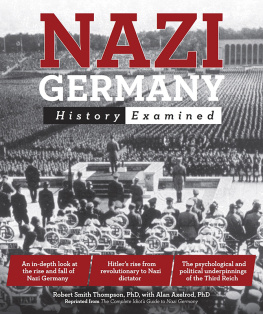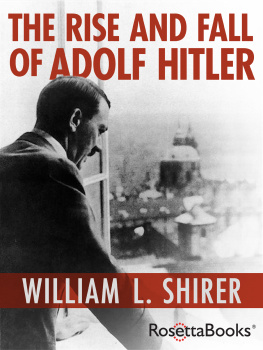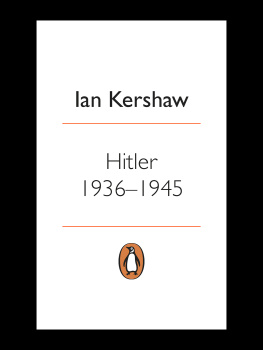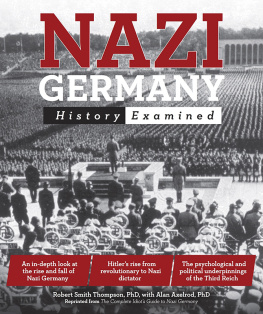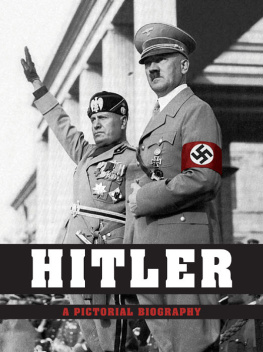Adolf Hitler
A Biography
Ileen Bear
Alpha Editions
Copyright 2016
ISBN:9789386019479
Design and Setting By
Alpha Editions
email
All rights reserved. No part of this publication may be reproduced, distributed, or transmitted in any form or by means, including photocopying, recording, or other electronic or mechanical methods, without the prior written permission of the publisher.
The views and characters expressed in the book are of the author and his/her imagination and do not represent the views of the Publisher.
Introduction
Adolf Hitler (German: [ad?lf h?tl?]; 20 April 1889 30 April 1945) was a German politician who was the leader of the Nazi Party (NSDAP), Chancellor of Germany from 1933 to 1945, and Fhrer (leader) of Nazi Germany from 1934 to 1945. As dictator of Nazi Germany he initiated World War II in Europe with the invasion of Poland in September 1939 and was a central figure of the Holocaust.
Born an Austrian citizen and raised near Linz, Hitler moved to Germany in 1913 and was decorated during his service in the German Army in World War I. He joined the precursor of the NSDAP, the German Workers Party, in 1919 and became leader of the NSDAP in 1921. In 1923, he attempted a coup in Munich to seize power. The failed coup resulted in Hitlers imprisonment, during which time he dictated his autobiography and political manifesto Mein Kampf (My Struggle). After his release in 1924, Hitler gained popular support by attacking the Treaty of Versailles and promoting Pan-Germanism, anti-Semitism, and anticommunism with charismatic oratory and Nazi propaganda. Hitler frequently denounced international capitalism and communism as being part of a Jewish conspiracy.
By 1933, the Nazi Party was the largest elected party in the German Reichstag, which led to his appointment as Chancellor on 30 January 1933. Following fresh elections won by his coalition, the Reichstag passed the Enabling Act, which began the process of transforming the Weimar Republic into Nazi Germany, a one- party dictatorship based on the totalitarian and autocratic ideology of National Socialism. Hitler aimed to eliminate Jews from Germany and establish a New Order to counter what he saw as the injustice of the post-World War I international order dominated by Britain and France. His first six years in power resulted in rapid economic recovery from the Great Depression, the effective abandonment of restrictions imposed on Germany after World War I, and the annexation of territories that were home to millions of ethnic Germansactions which gave him significant popular support.
Hitler sought Lebensraum (living space) for the German people. His aggressive foreign policy is considered to be the primary cause of the outbreak of World War II in Europe. He directed large-scale rearmament and on 1 September 1939 invaded Poland, resulting in British and French declarations of war on Germany. In June 1941, Hitler ordered an invasion of the Soviet Union. By the end of 1941 German forces and the European Axis powers occupied most of Europe and North Africa. Failure to defeat the Soviets and the entry of the United States into the war forced Germany onto the defensive and it suffered a series of escalating defeats. In the final days of the war, during the Battle of Berlin in 1945, Hitler married his long-time lover, Eva Braun. On 30 April 1945, less than two days later, the two committed suicide to avoid capture by the Red Army, and their corpses were burned.
Under Hitlers leadership and racially motivated ideology, the Nazi regime was responsible for the genocide of at least 5.5 million Jews and millions of other victims whom he and his followers deemed Untermenschen (sub-humans) and socially undesirable. Hitler and the Nazi regime were also responsible for the killing of an estimated 19.3 million civilians and prisoners of war. In addition, 29 million soldiers and civilians died as a result of military action in the European Theatre of World War II. The number of civilians killed during the Second World War was unprecedented in warfare, and constitutes the deadliest conflict in human history.
If you win, you need not have to explain... If you lose, you should not be there to explain!
Childhood
Hitlers father Alois Hitler, Sr. (1837 1903) was the illegitimate child of Maria Anna Schicklgruber. The baptismal register did not show the name of his father, and Alois initially bore his mothers surname Schicklgruber. In 1842, Johann Georg Hiedler married Aloiss mother Maria Anna. She died in 1847 and Johann Georg Hiedler died in 1856. Alois was brought up in the family of Hiedlers brother, Johann Nepomuk Hiedler. In 1876, Alois was legitimated and the baptismal register changed by a priest to register Johann Georg Hiedler as Aloiss father (recorded as Georg Hitler). Alois then assumed the surname Hitler, also spelled as Hiedler, Httler, or Huettler. The Hitler surname is probably based on one who lives in a hut (Standard German Htte for hut) or on shepherd (Standard German hten for to guard); alternatively, it might be derived from the Slavic words Hidlar or Hidlarcek (small cottager or small holder).
Nazi official Hans Frank suggested that Aloiss mother had been employed as a housekeeper for a Jewish family in Graz, and that the familys 19-year-old son Leopold Frankenberger had fathered Alois. No Frankenberger was registered in Graz during that period, and no record has been produced of Leopold Frankenbergers existence, so historians dismiss the claim that
Aloiss father was Jewish.
Hitler as a Baby
Adolf Hitler was born on 20 April 1889 in Braunau am Inn, a town in Austria-Hungary (in present-day Austria), close to the border with the German Empire. He was the fourth of six children to Alois Hitler and Klara Plzl (18601907). Hitlers older siblingsGustav, Ida, and Ottodied in infancy. When Hitler was three, the family moved to Passau, Germany. There he acquired the distinctive lower Bavarian dialect, rather than Austrian German, which marked his speech throughout his life. The family returned to Austria and settled in Leonding (near Linz) in 1894, and in June 1895 Alois retired to a small landholding at Hafeld, near Lambach, where he farmed and kept bees. Hitler attended Volksschule (a state-owned school) in nearby Fischlham.
The move to Hafeld coincided with the onset of intense father- son conflicts caused by Hitlers refusal to conform to the strict discipline of his school. Alois Hitlers farming efforts at Hafeld ended in failure, and in 1897 the family moved to Lambach. The eight-year-old Hitler took singing lessons, sang in the church choir, and even considered becoming a priest. In 1898 the family returned permanently to Leonding. The death of his younger brother Edmund, who died from measles in 1900, deeply affected Hitler. He changed from a confident, outgoing, conscientious student to a morose, detached, sullen boy who constantly fought with his father and teachers.
Alois had made a successful career in the customs bureau and wanted his son to follow in his footsteps. Hitler later dramatised an episode from this period when his father took him to visit a customs office, depicting it as an event that gave rise to an unforgiving antagonism between father and son, who were both strong-willed. Ignoring his sons desire to attend a classical high school and become an artist, Alois sent Hitler to the Realschule in Linz in September 1900. Hitler rebelled against this decision, and in Mein Kampf revealed that he intentionally did poorly in school, hoping that once his father saw what little progress I was making at the technical school he would let me devote myself to my dream.


